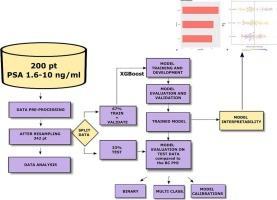Machine learning-based optimization of the prostate health index for prostate cancer detection
IF 2.9
3区 医学
Q2 MEDICAL LABORATORY TECHNOLOGY
引用次数: 0
Abstract
The Prostate Health Index (PHI) is composed of the prostate-specific antigen (PSA), free PSA (fPSA), and the [-2]pro-PSA isoform (p2PSA). The aim of the study was to modify the PHI using machine learning (ML) and to compare its prognostic performance with traditional PHI for any-, low- and high-grade prostate cancer (PCa) detection on biopsy. To obtain better-balanced data set we used the over-sampling strategy. The extreme gradient boosting was considered as an ML algorithm. Predictive performance was quantified by the area under the curve (AUC), multiclass classification measures, calibration, and decision curve analysis. We used the feature importance and the SHapley Additive exPlanations value for interpretation of the model. There were 200 patients in the initial pool, but after resampling, the dataset had equal number of data points for each cancer grade (114), i.e. 342 data points in total. The AUC of the modified PHI was significantly higher than those of the traditional PHI (0.898 vs 0.808, 0.868 vs 0.581, and 0.983 vs 0.74) for any, low-grade, and high-grade PCa. The modified PHI had higher net benefit compared to the traditional PHI. However, the ML PHI model had sigmoid-shaped reliability plots. The p2PSA had the highest influence, and the fPSA was the most important factor for risk estimate by the ML PHI. The modified ML PHI model for predicting histological grade of PCa showed superior performance in comparison to the traditional PHI. However, additional studies are required before it can be integrated into routine clinical care.

基于机器学习的前列腺健康指数优化前列腺癌检测。
前列腺健康指数(PHI)由前列腺特异性抗原(PSA)、游离PSA (fPSA)和[-2]前PSA亚型(p2PSA)组成。该研究的目的是使用机器学习(ML)修改PHI,并将其与传统PHI在活检中检测任何、低级别和高级别前列腺癌(PCa)的预后性能进行比较。为了获得更好的平衡数据集,我们使用了过采样策略。极端梯度增强算法是一种机器学习算法。预测性能通过曲线下面积(AUC)、多类分类措施、校准和决策曲线分析来量化。我们使用特征重要性和SHapley加性解释值来解释模型。初始池中有200名患者,但重新采样后,数据集中每个癌症级别的数据点数量相等(114),即总共342个数据点。改良PHI的AUC显著高于传统PHI (0.898 vs 0.808, 0.868 vs 0.581, 0.983 vs 0.74),适用于任何低级别和高级别PCa。与传统的PHI相比,改进的PHI具有更高的净效益。而ML - PHI模型具有s型的信度图。p2PSA的影响最大,而fPSA是ML PHI评估风险的最重要因素。与传统的PHI模型相比,改进的ML PHI模型预测PCa的组织学分级表现出优越的性能。然而,在将其纳入常规临床护理之前,还需要进行更多的研究。
本文章由计算机程序翻译,如有差异,请以英文原文为准。
求助全文
约1分钟内获得全文
求助全文
来源期刊

Clinica Chimica Acta
医学-医学实验技术
CiteScore
10.10
自引率
2.00%
发文量
1268
审稿时长
23 days
期刊介绍:
The Official Journal of the International Federation of Clinical Chemistry and Laboratory Medicine (IFCC)
Clinica Chimica Acta is a high-quality journal which publishes original Research Communications in the field of clinical chemistry and laboratory medicine, defined as the diagnostic application of chemistry, biochemistry, immunochemistry, biochemical aspects of hematology, toxicology, and molecular biology to the study of human disease in body fluids and cells.
The objective of the journal is to publish novel information leading to a better understanding of biological mechanisms of human diseases, their prevention, diagnosis, and patient management. Reports of an applied clinical character are also welcome. Papers concerned with normal metabolic processes or with constituents of normal cells or body fluids, such as reports of experimental or clinical studies in animals, are only considered when they are clearly and directly relevant to human disease. Evaluation of commercial products have a low priority for publication, unless they are novel or represent a technological breakthrough. Studies dealing with effects of drugs and natural products and studies dealing with the redox status in various diseases are not within the journal''s scope. Development and evaluation of novel analytical methodologies where applicable to diagnostic clinical chemistry and laboratory medicine, including point-of-care testing, and topics on laboratory management and informatics will also be considered. Studies focused on emerging diagnostic technologies and (big) data analysis procedures including digitalization, mobile Health, and artificial Intelligence applied to Laboratory Medicine are also of interest.
 求助内容:
求助内容: 应助结果提醒方式:
应助结果提醒方式:


